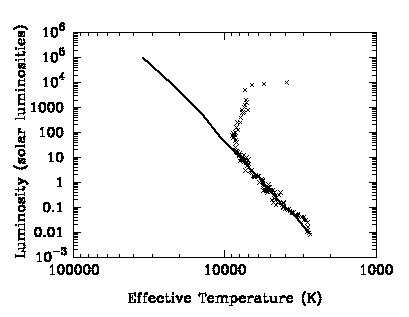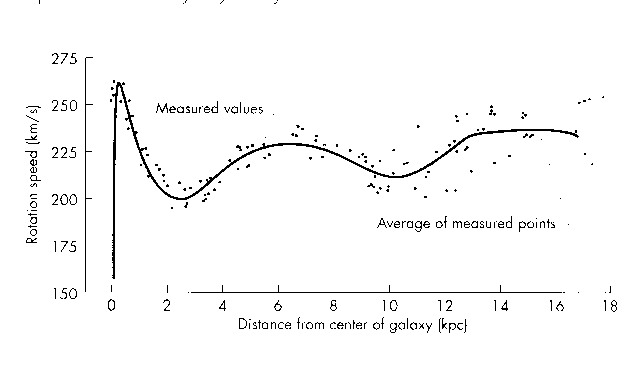

Second Hour Exam |
1999 April 7 |
Question #1: b) their cores are hotter and fuse hydrogen more quickly.
This one comes (quite literally) straight from class. Even though massive stars have more hydrogen (after all, they're more massive), their interiors are so much hotter than the interiors of low mass stars that they use up their hydrogen supply much more quickly. An O star of say, 10 solar masses, will use up its hydrogen supply in only 10 million years; that's a Main Sequence lifetime that's about a thousand times shorter than that of the Sun.
Question #2: d) You don't have enough information to determine which cluster is closer.
Another "Question to Ponder" straight out of class. Nowhere in the question does it say that either of these stars is a Main Sequence star. If they're not both Main Sequence stars, then you can't assume that they have the same luminosity. If, for example, one of these stars is a red giant and the other is a Main Sequence stars, their luminosities might differ by a factor of a thousand or more.
Since you don't know their luminosities, you can't figure out their distances from the flux measurements, and therefore you can't tell for sure which cluster is closer.
Oh my! A question right out of the Observing Lab. I thought we just had to show up at the Observatory. I didn't realize that we had to pay attention. You do. Re-read Observing Lab #2, and beware of questions based on all three Observing labs on the final.
The color index, as defined in your textbook, in class, and in Lab #6, is the difference in the apparent magnitude of a star through different colored filters. It tells you the ratio of the fluxes at two different wavelengths, and from this, you can figure out the surface temperature of a star. Take a look at Lab #6 is you're puzzled by this.
Question #5: e) They will move rightward and downward.
Yet another "Question to Ponder." I wonder if you should review all of these before the final.... White dwarfs are basically how spheres of really dense matter, which are radiating light and therefore slowly cooling off (if they're radiating light, they're losing energy, and if they're losing energy, they're getting colder, since temperature is energy per particle). When blackbody radiators cool off they also become less luminous, so a white dwarf will move rightward (i.e., toward lower temperature), and downward (i.e., toward lower luminosity) in the Hertzsprung-Russell Diagram.
Question #6: a) studies of the motions of binary stars.
Really the only way to directly measure the mass of an object in astronomy is to watch how something else moves around it. Binary star systems provide us with that opportunity to measure the mass of some stars. Without binary star measurements, we would still be guessing at the masses of most stars, and we would have no idea about the mass-luminosity relationship for Main Sequence stars.
Question #7: a) thermal pressure from fusion in their cores.
The whole reason that Main Sequence stars can remain stable for as long as they fuse hydrogen is that the pressure caused by the energy generation in the core resists the in ward force of gravity. When a star stops fusing, its core loses the ability to push back, and the star becomes unstable.
Question #8: c) electron degeneracy pressure.
No fusion takes place in the centers of white dwarfs; that's why they're compressed to such high density by gravity. However, in these objects, the relentless push of gravity is balanced by electron degeneracy pressure, which is essentially the fact that electrons resist being pushed too close together.
Question #9: a) Dust does not absorb as efficiently in the infrared as it does in the optical.
The problem with seeing all of the stars in the galaxy is that the galaxy is a dusty place. There's a lot of stuff between the stars, and this stuff attenuates starlight. The light from distant stars has to pass through a lot of this stuff, and so is attenuated so much that we can't detect it.
Infrared photons, however, can penetrate much more effectively through this obscuring material. Consequently, the infrared light from distant stars is not attenuated as much, and enough of it gets through so that we can detect even the stars on the other side of the galaxy.
Question #10: c) The high rotation velocity of material in the outer reaches of the galaxy.
The only way to detect mass is by the motion of stuff around it. This is especially true for "dark matter," which is by definition non-luminous.
Question #1: A star cluster is a group of stars located together in space. All evidence indicates that these stars formed together at about the same time. Therefore, all of the stars in any one cluster have about the same age.
We can figure out the age of the cluster by looking at the cluster's Hertzsprung-Russell Diagram. Most of the stars in any cluster will appear on the Main Sequence, but depending on the age of the cluster, some stars will have evolved past their hydrogen fusing stage and will appear off the Main Sequence. Since massive stars use up their hydrogen supplies faster than low mass stars, they will be the first to depart from the Main Sequence. As a cluster ages, stars of lower and lower mass will finish their hydrogen fusing lifetime and evolve off the Main Sequence.
Therefore, we can determine the age of a cluster by looking for the most massive star that's still on the Main Sequence. The age of the cluster must be less than the time it takes this star to exhaust its core hydrogen fuel supply.
Therefore, the cluster whose H-R Diagram is depicted below left is younger than the cluster whose H-R Diagram is below right. More time must have passed for the left-hand cluster because stars of lower mass have already evolved off the Main Sequence.

|

|
Let's first start with the prevailing view. Before Shapley's work, it was widely believed that the Sun was located somewhere near the center of our galaxy. Why? Because if you count stars in the Milky Way, you find roughly the same number of stars in every direction, and therefore you conclude that we must be near the center of the system of stars. This conclusion was incorrect, mainly because of the effects of interstellar dust. The space between the stars in our galactic disk contains a fair amount of dust, and just as you can't see the mountains across the valley on a hazy day, you can't see distant stars in our galaxy. In both cases, the intervening material just isn't transparent enough.
Shapley was able to (literally!) get around the problem of dust absorption in the galactic plane by looking slightly above and below the galactic plane. He looked at globular clusters, which are giant clusters of 100,000 stars or more. For reasons that he didn't understand (and we're only just beginning to understand even now), globular clusters are found more often above and below the galactic disk than in it. Therefore, they weren't as subject to dust absorption, and Shapley could see most of the globular clusters in the galaxy, including many of the very distant ones.
When Shapley looked at the distribution of globular clusters on the sky, he noticed that there weren't roughly equal numbers of clusters in every direction. Instead, he found a substantial concentration of clusters in the direction of the constellation Sagittarius. He reasoned that the distribution of globular clusters should be centered on the center of our galaxy, and since it wasn't centered on us, we're not the center. By calculating the distance and direction to each of the globular clusters, Shapley was able to figure out that the center of the galaxy lay 25,000-30,000 light years away in the direction of Sagittarius.
Problem #1: This problem is pretty straightforward, although you have far more information that you actually need. From the front of your exam:
Problem #2, Part a): We can figure out how much energy is produced in a nuclear reaction by determining how much mass "disappears." Of course, it doesn't disappear, but it is converted into energy, and that's what we're looking for.
We start with 3 helium nuclei, so what's the mass of that? Well, it's three times the mass of one helium nucleus:
Problem #2, Part b): From Part a), we now know how much energy is produced by one reaction; if we knew how many reactions it would take to convert this mass of helium into carbon, then we'd just multiply the energy produced in one reaction by the total number of reactions to get the total energy produced.
So, let's figure out how many reactions it will take to convert a solar mass of helium to carbon. We can first figure out how many nuclei there are in this mass:
Problem #3: In this problem, we need to understand what a rotation curve is, and we need to be able to read the correct information from the provided graph. The rotation curve is a measure of the speed of material in our galaxy as a function of distance from the galaxy's center. This material is moving because of the influence of gravity, and if the galaxy is stable (and we think it is reasonably stable), then the motion of the material must be sufficient to oppose the pull of gravity.
We learned in class that the relationship between the motion of an orbiting body and the mass of the material interior to its orbit is as follows:

The plot tells us that at a distance of 6 kpc from the center of the galaxy, objects move with a speed of 225 km/s.
Now we need to get these quantities (6 kpc, 225 km/s) into appropriate units so that we can use them in the above mass formula. Why do we need to convert units? Take a look at the units for G, Newton's gravitational constant: